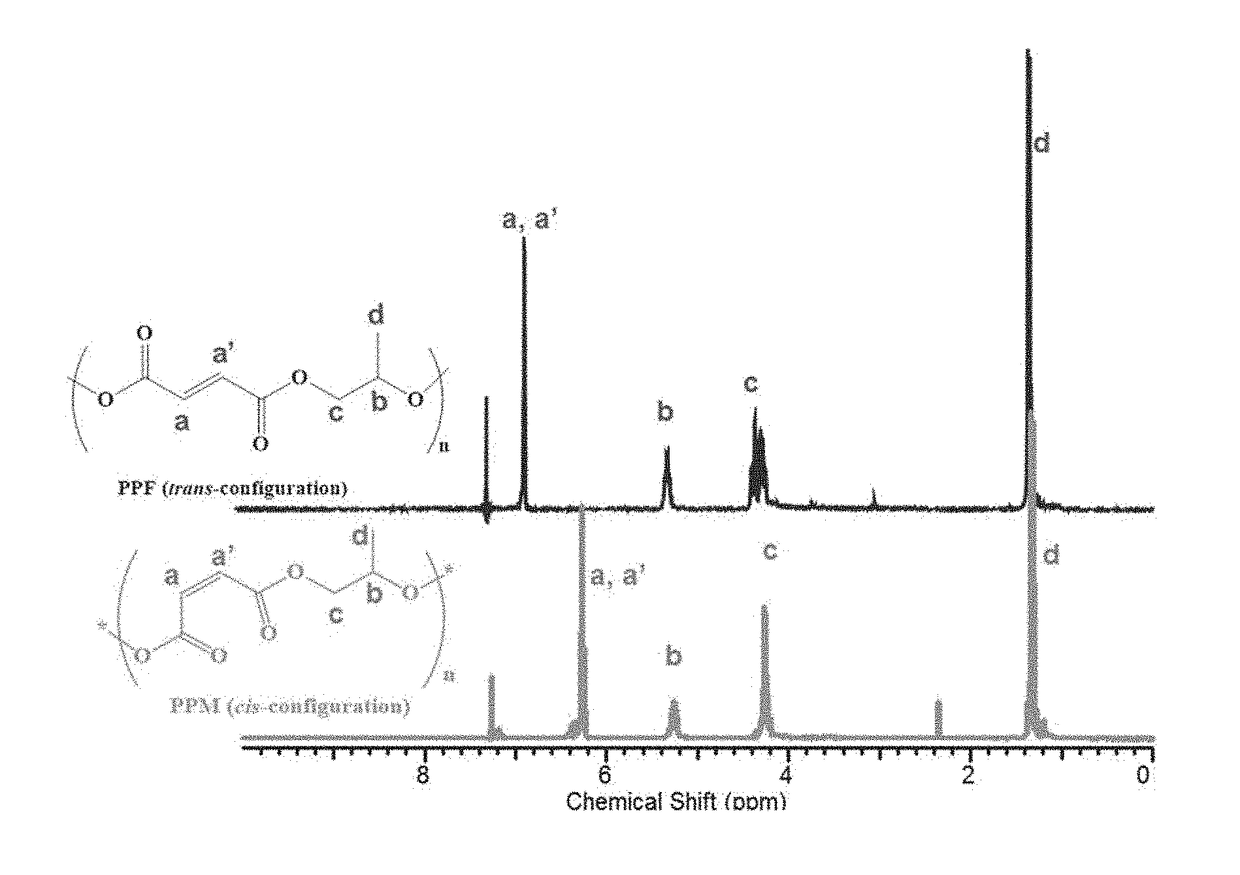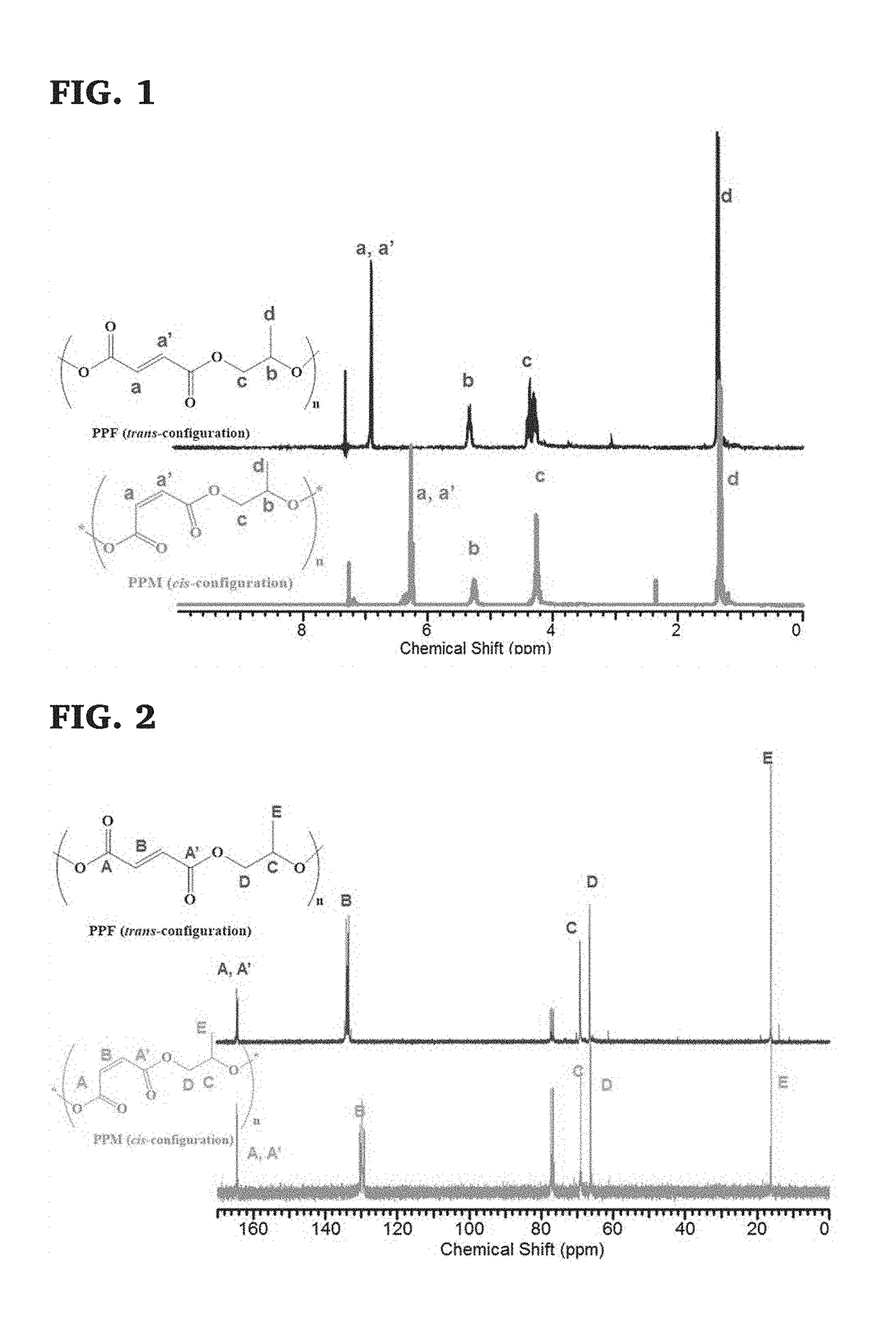Well-defined degradable poly(propylene fumarate) polymers and scalable methods for the synthesis thereof
a polymer and polymer technology, applied in the field of new poly (propylene fumarate) polymer and methods for making poly (propylene fumarate) polymers, can solve the problems of localized acidosis and inflammation, limited neotissue remodeling or vascularization, and the availability of resorbable photo-cross linkable polymers, and achieves the effect of making inexpensively
- Summary
- Abstract
- Description
- Claims
- Application Information
AI Technical Summary
Benefits of technology
Problems solved by technology
Method used
Image
Examples
example 1.1
Representative Synthesis of Poly(maleic anhydride-co-propylene oxide)
[0113]Maleic anhydride (MAn) 70.06 g (714 mmol) and propylene oxide (PO) 50.0 mL (714 mmol) were dissolved in 100 mL of toluene in a 500 mL round-bottom flask at room temperature under a nitrogen atmosphere. After all of the monomers were dissolved in toluene with constant magnetic stirring, 272.34 mg (2.38 mmol, molar ratio of MAn / Mg(OEt)2=300:1, Mg(OEt)2 was added to the mixture and the flask was moved into a silicone oil bath equipped with a reflux condenser to initiate the polymerization at 80° C. The polymerization was allowed to proceed and aliquots were taken at defined time points (3 h, 6 h, 18 h, 24 h and 48 h). Similar studies incorporating molar ratio of MAn / Mg(OEt)2=200:1, 100:1 were also conducted. After the designated polymerization time, the system was cooled to ambient temperature under nitrogen, and subjected to reduced pressure conditions to remove the volatile materials. The residue was diluted w...
example 1.2
General Procedure for the Isomerization of Poly(maleic anhydride-co-propylene oxide)
[0114]Diethylamine (0.15 eq.) was added to poly(maleic anhydride-co-propylene oxide) after dissolving the polymer in CHCl3 in a round-bottom flask equipped with a water reflux condenser to start isomerization at 55° C. for 24 h under a nitrogen atmosphere. The mixture was then concentrated by rotary evaporation and washed with phosphate buffer saline solution (0.5M, pH=6) to remove the diethylamine. The organic layer was then precipitated into hexane several times to remove impurities. The precipitate was collected and kept in vacuo overnight at room temperature to remove all volatiles. Then, 1H NMR was used for characterization. 1H NMR (300 MHz, Chloroform-d) δ ppm 1.11-1.43 (d, 3H, OCH2CH(CH3)O), 4.09-4.39 (m, 2H, OCH2CH(CH3)O), 5.21-5.35 (m, 1H, OCH2CH(CH3)O), 6.83-6.91 (m, 2H, CH═CH (trans-configuration)).
example 2
Large Batch Synthesis (Mn=1.5 kDa)
[0115]1. Synthesis of Poly(maleic anhydride-co-propylene oxide)
[0116]Maleic anhydride (2856 mmol) and propylene oxide (2856 mmol) were dissolved in toluene (400 mL) in a 2 L round-bottom flask at ambient temperature under nitrogen. After all monomers were dissolved in toluene with magnetic stirring, Mg(OEt)2 (119 mmol; molar ratio of MAn:Mg(OEt)2=24:1) was added to the mixture and the flask was moved into a silicone oil bath equipped with a water reflux condenser to start polymerization at 80° C. for 40 h. After the designated polymerization time, the system was cooled to room temperature under nitrogen, evaporated to remove all volatiles and then was diluted with CHCl3, washed with water containing trace amount of HCl to remove the inorganic compound. The organic layer was poured into hexane after rotary evaporation, and the precipitated polymer mixture was re-dissolved in a minimal amount of CHCl3 that was then concentrated by rotary evaporation. ...
PUM
| Property | Measurement | Unit |
|---|---|---|
| molecular mass distribution | aaaaa | aaaaa |
| Mn | aaaaa | aaaaa |
| Tg | aaaaa | aaaaa |
Abstract
Description
Claims
Application Information
 Login to View More
Login to View More - R&D
- Intellectual Property
- Life Sciences
- Materials
- Tech Scout
- Unparalleled Data Quality
- Higher Quality Content
- 60% Fewer Hallucinations
Browse by: Latest US Patents, China's latest patents, Technical Efficacy Thesaurus, Application Domain, Technology Topic, Popular Technical Reports.
© 2025 PatSnap. All rights reserved.Legal|Privacy policy|Modern Slavery Act Transparency Statement|Sitemap|About US| Contact US: help@patsnap.com



